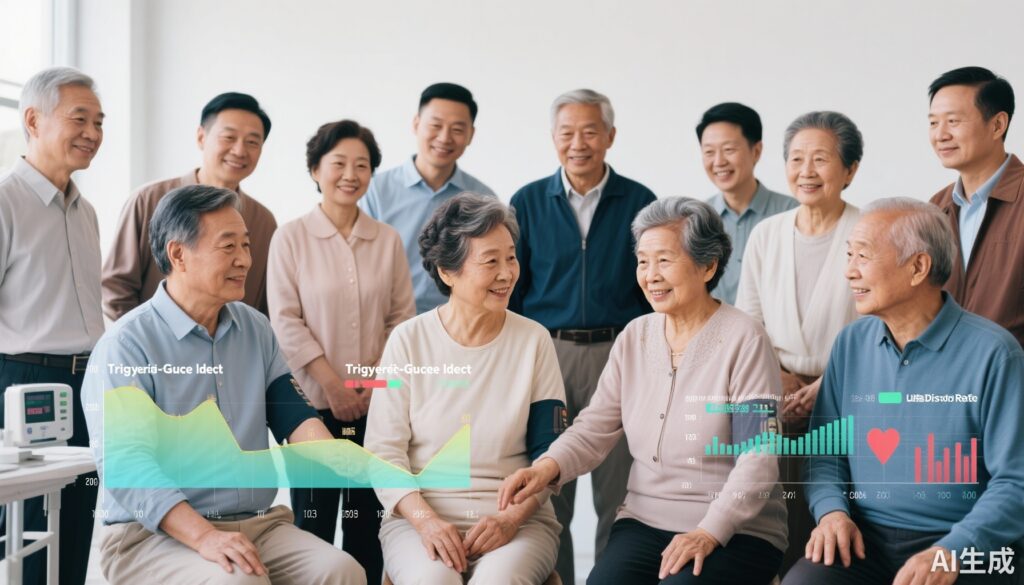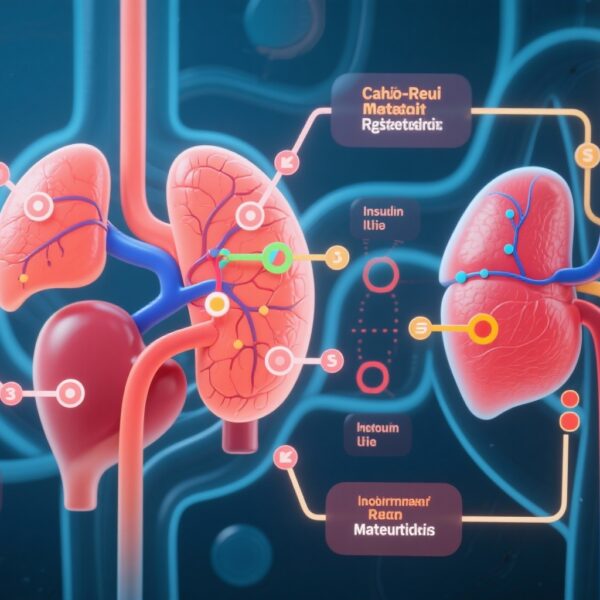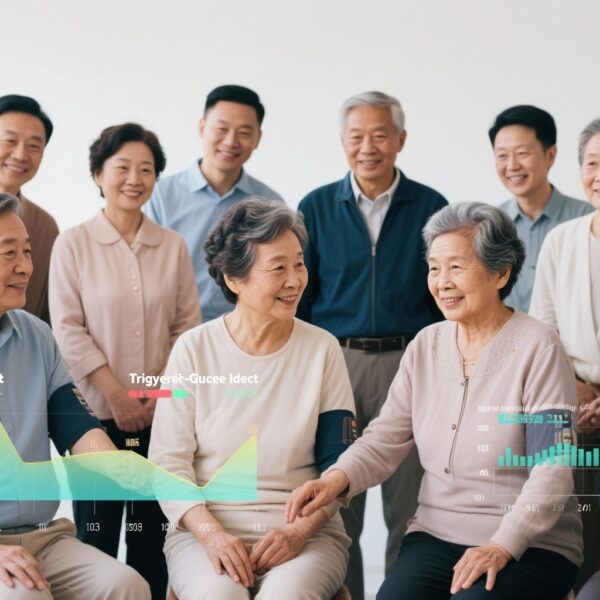Highlight
– High TyG-related indices combined with low eGDR independently and jointly increase the risk of cardiometabolic multimorbidity (CMM) in middle-aged and older Chinese adults.
– TyG-related indices and eGDR improve prediction models for CMM, with TyG-BMI showing the greatest enhancement.
– Mediation analyses reveal eGDR partly mediates the effect of TyG-related indices on CMM, highlighting interlinked insulin resistance pathways.
– No significant interaction effect between TyG indices and eGDR suggests additive, not synergistic, contribution to CMM risk.
Study Background
Cardiometabolic diseases (CMDs)—including cardiovascular disease, type 2 diabetes mellitus, and related metabolic disorders—are leading causes of morbidity and mortality globally, with mounting prevalence in middle-aged and older populations. Cardiometabolic multimorbidity (CMM), defined as the coexistence of two or more CMDs, significantly worsens patient prognosis and increases healthcare burden. Insulin resistance (IR) is a shared pathophysiological mechanism underlying CMDs and CMM. Identifying reliable surrogate markers for IR that forecast CMM risk is critical for early intervention and prevention strategies.
The triglyceride-glucose (TyG) index and its obesity-adjusted derivatives—TyG-body mass index (TyG-BMI), TyG-waist circumference (TyG-WC), and TyG-waist-to-height ratio (TyG-WHtR)—have emerged as convenient surrogate indicators integrating lipid and glycemic status to estimate IR. The estimated glucose disposal rate (eGDR), calculated from clinical parameters, also estimates insulin sensitivity. Both TyG-related indices and eGDR have been associated with individual CMD risks, but their joint effect on CMM remains poorly characterized, especially in large, population-based Chinese cohorts.
Study Design
This prospective cohort study utilized data from the China Health and Retirement Longitudinal Study (CHARLS), encompassing a nationally representative sample of middle-aged and older Chinese adults. A total of 5,854 participants (47.5% male, median age 57 years) were included. Researchers calculated the TyG index and its obesity-related derivatives alongside eGDR for each participant and categorized them dichotomously based on median values.
Participants were followed longitudinally to record incident CMM events. Statistical analyses included univariate and multivariate Cox regression models to estimate hazard ratios (HRs) for CMM associated with TyG indices, eGDR, and their combinations. Dose–response relationships were investigated using restricted cubic splines (RCS). Predictive performance enhancements by adding these indices to baseline models were assessed by area under the receiver operating characteristic curve (AUC), net reclassification improvement (NRI), and integrated discrimination improvement (IDI). Mediation and interaction effects between the indices were also explored.
Key Findings
The study revealed significantly higher risks of CMM in participants with combinations of high TyG-related indices and low eGDR compared to the reference group (low TyG indices plus high eGDR). Specific hazard ratios (HRs) with 95% confidence intervals (CIs) were:
- TyG: HR 3.59 (2.28–5.65)
- TyG-BMI: HR 3.40 (2.30–5.02)
- TyG-WC: HR 3.85 (2.58–5.75)
- TyG-WHtR: HR 3.62 (2.43–5.39)
These results underscore that combined abnormalities in lipid-glucose metabolism and reduced glucose disposal capacity heighten CMM risk more than either alone.
In terms of predictive capabilities, integrating combined TyG-related indices and eGDR into a baseline risk model significantly improved discrimination metrics for CMM risk:
| Index Combination | AUC | NRI | IDI |
|---|---|---|---|
| TyG + eGDR | 0.713 | 0.363 | 0.008 |
| TyG-BMI + eGDR | 0.729 | 0.479 | 0.011 |
| TyG-WC + eGDR | 0.716 | 0.419 | 0.010 |
| TyG-WHtR + eGDR | 0.717 | 0.379 | 0.010 |
All improvements were statistically significant (p < 0.05), with TyG-BMI providing the highest enhancement in predictive performance.
Mediation analysis indicated that eGDR significantly mediated the association between all TyG-related indices and CMM risk, highlighting a partial causal pathway reflecting insulin sensitivity. Conversely, only obesity-related TyG indices mediated the relationship between eGDR and CMM, suggesting adiposity components influence glucose disposal impacts.
Importantly, interaction analyses revealed no statistically significant additive or multiplicative interaction between TyG indices and eGDR for CMM risk, indicating their effects are largely independent and additive rather than synergistic.
Expert Commentary
The study by Ruan et al. provides valuable insights linking easily measurable surrogate markers for IR with the complex phenotype of CMM in a large, ethnically homogeneous Chinese cohort. Utilizing both lipid-glucose based indices and an estimate of glucose disposal captures different facets of IR that together enhance CMM risk identification.
While the study is observational and cannot ascertain causality, the mediation findings support a plausible biological pathway linking IR to multimorbidity accumulation. The lack of interaction between indices underscores the multifactorial nature of CMM, where diverse metabolic derangements increment risk cumulatively.
Study limitations include reliance on median cutoffs which may reduce granularity, potential residual confounding, and generalizability limited to middle-aged and older Chinese populations. Future studies should validate findings in other ethnic groups and evaluate the utility of these markers in clinical risk prediction models and intervention trials.
Conclusion
This nationwide cohort study confirms that high TyG-related indices combined with low eGDR independently and jointly predict elevated risk of cardiometabolic multimorbidity in middle-aged and older Chinese adults. These surrogate markers of insulin resistance, when used together, improve early identification of individuals at higher risk for CMM and may guide targeted preventive strategies.
The findings support integration of TyG indices and eGDR into routine risk assessments for cardiometabolic health, emphasizing the need for multifaceted approaches addressing adiposity, glycemic control, and insulin sensitivity to curb the growing burden of multimorbidity.
Funding and ClinicalTrials.gov
Funding sources were not detailed in the original publication. The China Health and Retirement Longitudinal Study (CHARLS) is a publicly funded longitudinal cohort supported by national ministries in China.
References
Ruan X, Ling Y, Chen J, Xiang Y, Ruan H, Zhang W, Jing L, Gao X, He Y, Lu X, Chang T, Xu J, Chen J. Joint effects of triglyceride glucose index and its obesity-related derivatives with estimated glucose disposal rate on cardiometabolic multimorbidity in middle-aged and older Chinese adults: a nationwide cohort study. Cardiovasc Diabetol. 2025 Oct 2;24(1):382. doi: 10.1186/s12933-025-02939-7. PMID: 41039463; PMCID: PMC12492775.



